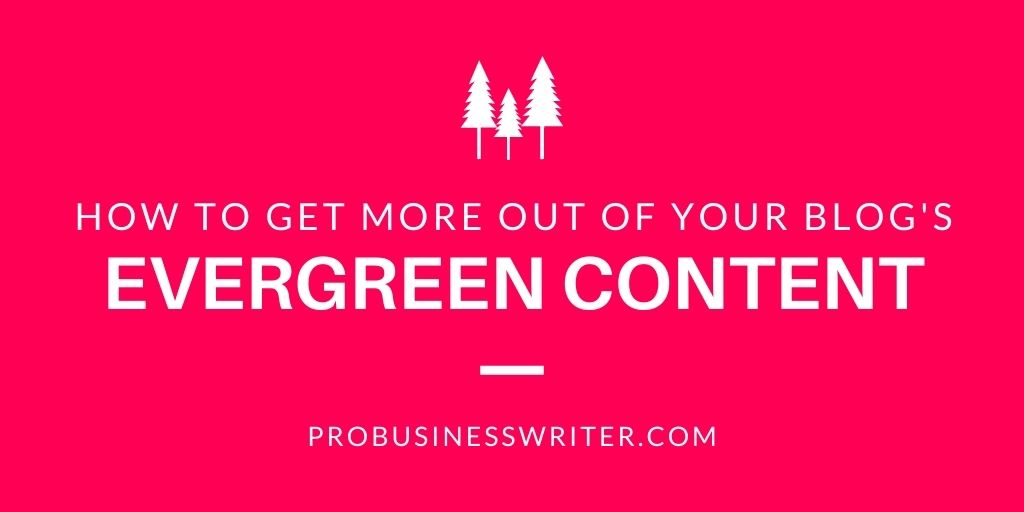 If you run a blog, either for your company or as a business on its own, one of your biggest financial and time commitments will be creating content. Sometimes that content will be timely. But the bulk of your blog content, and the content with the greatest potential to deliver business results, will likely be what’s known as “evergreen content.”
If you run a blog, either for your company or as a business on its own, one of your biggest financial and time commitments will be creating content. Sometimes that content will be timely. But the bulk of your blog content, and the content with the greatest potential to deliver business results, will likely be what’s known as “evergreen content.”
Today let’s explore what it means for content to be “evergreen,” and how you can get more out of these blog posts.
What is Evergreen Content?
Evergreen content is content that remains relevant and in-demand for an extended period of time.
For example, a tutorial article on how to improve your public speaking skills would be evergreen. Readers would find that article useful for years to come.
On the other hand, news and other timely content is not evergreen. In most cases, a breaking news story today won’t have much value to your average reader years down the road. The same is true of time-limited content like a “best of” list for a specific year. Those products, fashions, etc. will be replaced before long.
Why You Should Build a Strong Base of Evergreen Content
Evergreen content can be an important part of any blog built for professional reasons, from a company’s blog to a profitable niche blog.
Here are some of the reasons you’ll want to build a solid base of this kind of content, ideally from the start:
- Evergreen content doesn’t go out-of-date quickly.
- Evergreen topics can maintain high search volumes perennially.
- You won’t have to update the content often, if at all.
- Evergreen blog posts continually build organic links over the long-term.
- You can repurpose evergreen posts (into white papers, social media posts, audio and video content, infographics, and more).
Now that you understand the benefits of publishing evergreen content, what exactly does that include?
10 Types of Evergreen Blog Posts
Here are ten popular types of evergreen content you can publish to your company blog (or any niche blog):
- Industry definitions or glossaries (clarifying key concepts)
- Historical posts (such as the history of your industry or a certain relevant industry issue)
- How-to posts / Tutorials (as long as they don’t rely on something that will quickly become dated)
- FAQs (addressing common reader questions)
- Case studies (showcasing your work with past customers or clients)
- Tools and templates (as long as they don’t rely on technology that could go out-of-date)
- List posts (where the featured items or ideas won’t change often; think “10 Small Business Blogging Prompts” vs “10 Best Restaurants in X City”)
- Checklists (focused on topics that are always in-demand, and ideally repeatable)
- Expert tips (positioning you or someone in your company as an authority)
- Interviews (with influential people in your company or industry)
You’ll notice none of these are inherently timely in nature. That’s what makes them evergreen. But be careful with your topic choices, or you might change that.
For example, while tutorials can be evergreen, if you write a how-to post about a product or service that could become dated, you’ll lose those benefits.
How to Make Your Evergreen Content Work Harder for You
One of the best things about evergreen blog posts is how hard that content can work for your business. To get the most out of these articles, consider doing the following:
- Create several social media posts from each evergreen post on your blog.
- Schedule those evergreen updates not once, but repeatedly. You can re-feature them for years.
- Invest more in evergreen posts by creating add-on content (like checklists and worksheets), and use those downloads to build your email list.
- Combine some of your evergreen articles into a book or e-book you can sell.
- Build up new evergreen content around your biggest posts, such as more in-depth posts on tips mentioned in longer articles. Then interlink them into a series.
- If you run a company podcast or video series, create episodes based on your best evergreen posts.
- Consider creating a presentation, or even a course, built around your evergreen articles.
- Continue promoting your evergreen blog posts. It won’t become outdated any time soon, so keep driving new eyes to it.
- While you might not need to update the article much, monitor each evergreen post’s search engine rankings and periodically optimize it to keep new visitors coming to your site.
Evergreen content will be some of the most valuable material you ever post to your blog. So make the most of it. Maximize the promotional potential of your blog by creating these long-relevant resources, and you’ll attract new visitors, and customers, for years to come.
Do you need more evergreen content ideas specific to your business, or do you need help creating that content? Contact me today to find out how my freelance blogging services might meet your needs.
